Diaphragm Pump CFD Simulation, ANSYS Fluent Training
$210.00 $105.00 Student Discount
- The problem numerically simulates the Diaphragm Pump using ANSYS Fluent software.
- We design the 2-D model with the Design Modeler software.
- We mesh the model with ANSYS Meshing software; the element number equals 222,986.
- We perform this simulation as unsteady (Transient).
- We use the Dynamic Mesh Model to define deforming and moving zones.
- We use the user-defined function (UDF) to define the reciprocating motion.
To Order Your Project or benefit from a CFD consultation, contact our experts via email (info@mr-cfd.com), online support tab, or WhatsApp at +44 7443 197273.
There are some Free Products to check our service quality.
If you want the training video in another language instead of English, ask it via info@mr-cfd.com after you buy the product.
Description
Description
This project is related to the numerical simulation of the Diaphragm Pump using ANSYS Fluent software. A pump is a mechanical device for moving and transferring all liquids from one place to another. The pump takes mechanical energy from an external source, such as a motor, and transfers it to the fluid passing through it. As a result, the energy of the fluid increases after leaving the pump.
The energy transfer to the pump fluid is done in two dynamic and displacement methods. Therefore, pumps are divided into positive displacement pumps and dynamic or non-positive displacement pumps. Positive displacement pumps are divided into two groups: rotary (such as gear, lobe, and vane) and reciprocating (piston and diaphragm).
A diaphragm pump is one of the pumps to increase the hydraulic power of a fluid. Diaphragm pumps use a composite membrane, which flexes up-down over a water flow.
The pump membrane has an up-and-down reciprocating motion. When the membrane moves up, the liquid flow is sucked from the intake valve, and when the membrane moves down, the liquid flow is pushed towards the outlet valve.
In this project, we simulated the water flow inside a diaphragm pump. We aim to model the reciprocating motion of the membrane inside the pump. The gears’ reciprocating motion momentarily changes the fluid’s behavior in the pump. So, the mesh of the computing domain deforms over time.
We modeled the geometry of the project using Design Modeler software. The geometry is related to a diaphragm pump. The computational domain includes the internal space of the pump with a moving membrane. Then we meshed the model with ANSYS Meshing software. The model mesh is unstructured, and the number of cells equals 222,986.
Diaphragm Pump Methodology
In this project, the Dynamic Mesh Model was used. We generally use a dynamic mesh whenever we have a moving boundary or a deforming zone.
Here, a wall creates a wave motion. So this causes the mesh to deform over time. Therefore, we define a user-defined function (UDF) to define the wavy motion of the wall. To apply the wave motion to the wall, we must use the Grid Motion UDF.
According to the reciprocating motion of the membrane as a rigid body, the mesh zone near the moving membrane is deformed. So, for this zone, we use the Deforming option.
Due to the nature of this modeling, fluid behavior is time-dependent. Hence, we use the unsteady (Transient) solver.
Diaphragm Pump Conclusion
After the solution, we obtained pressure and velocity contours. Because the membrane moves over time, we obtained the animation of the velocity and pressure contours.
The results show that the pressure and velocity constantly change under the influence of the reciprocating motion of the non-stationary membrane. The reciprocating motion causes suction from the intake valve and compression to the outlet valve.
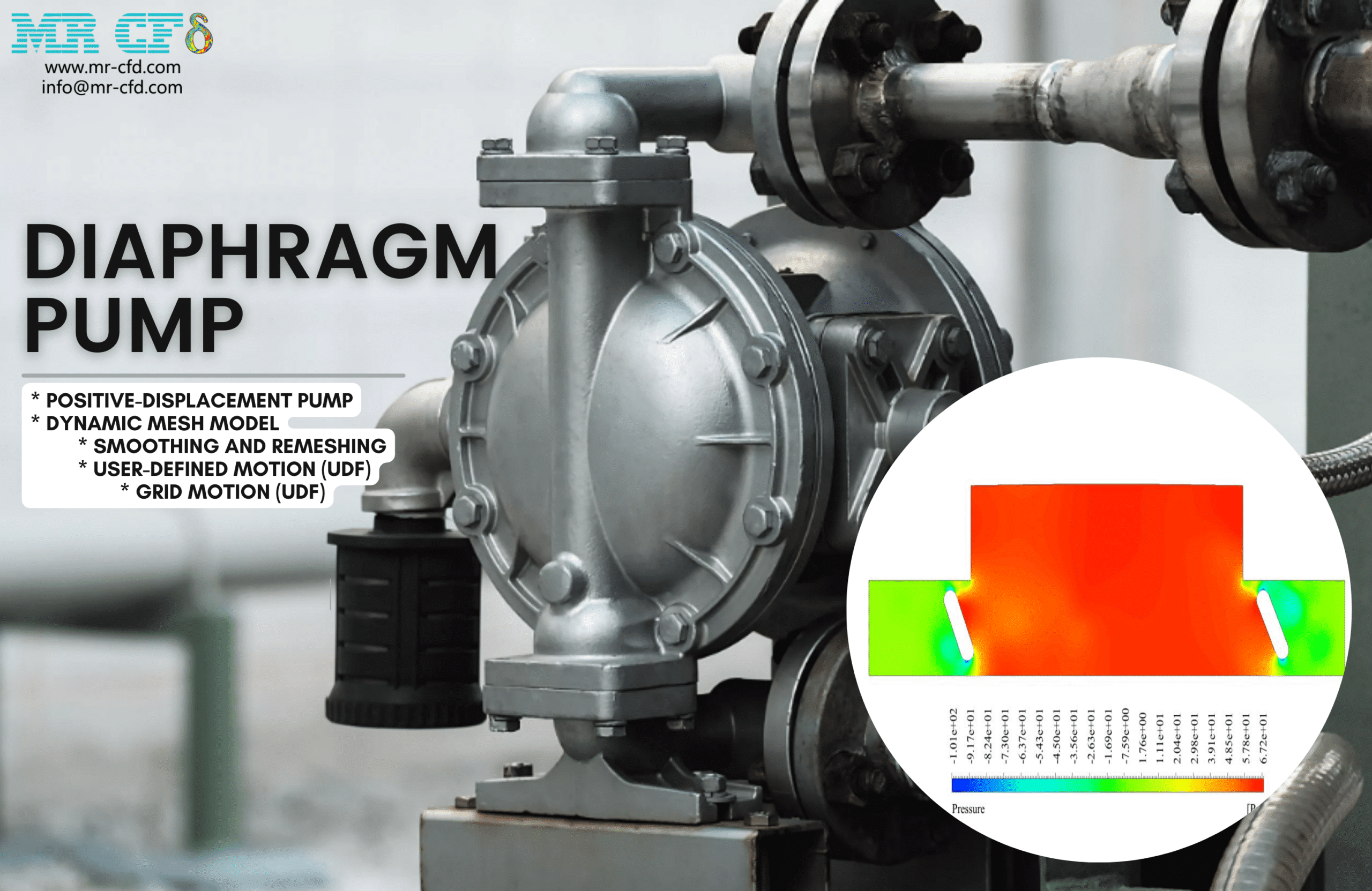



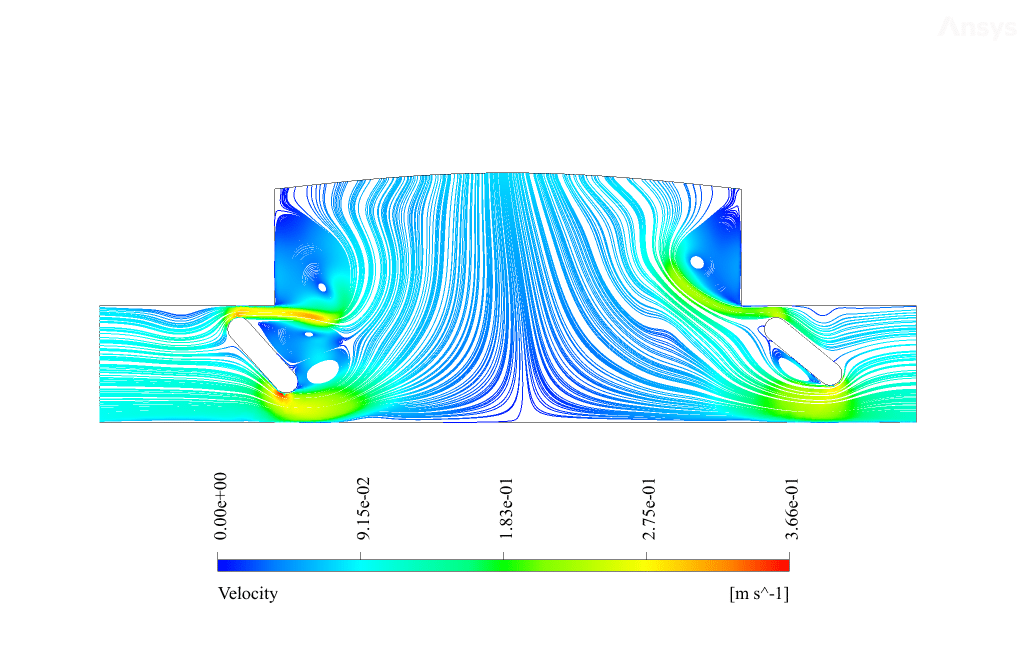
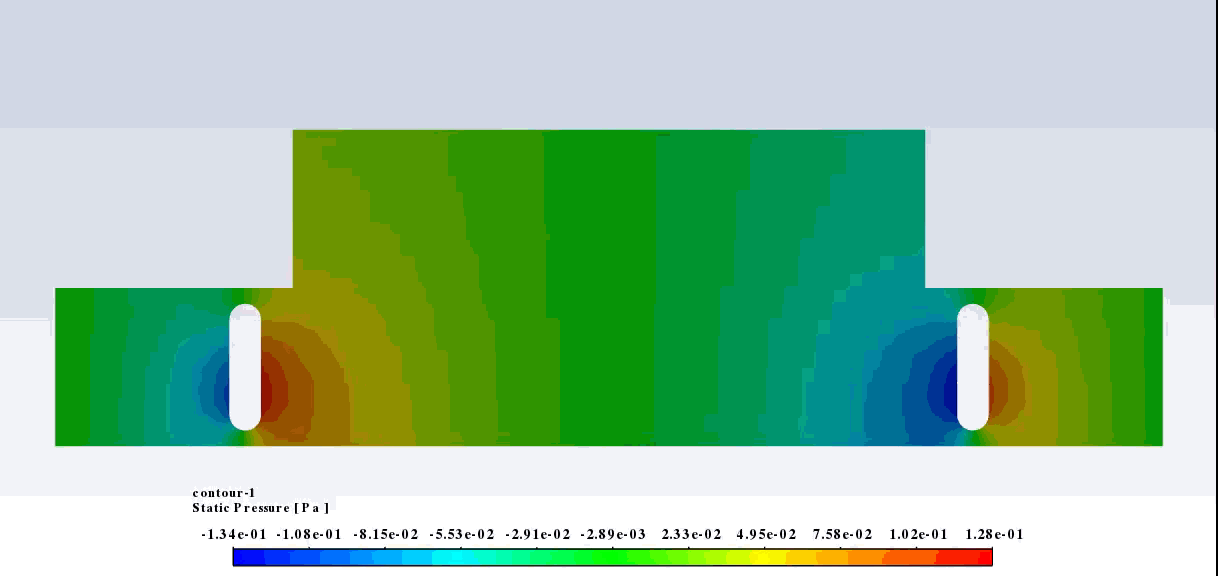
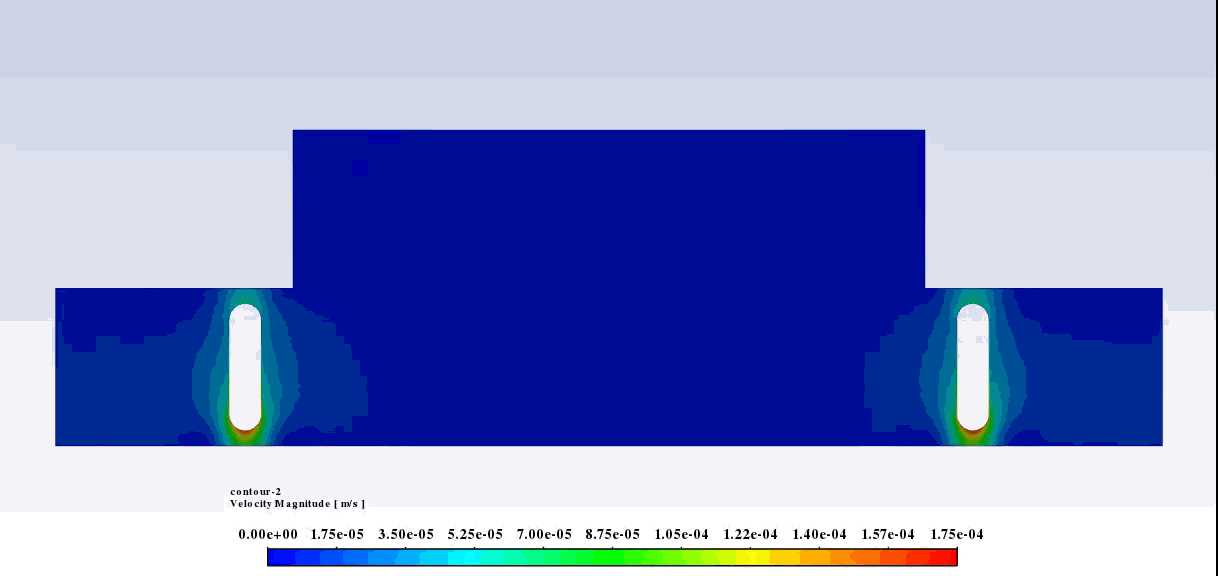
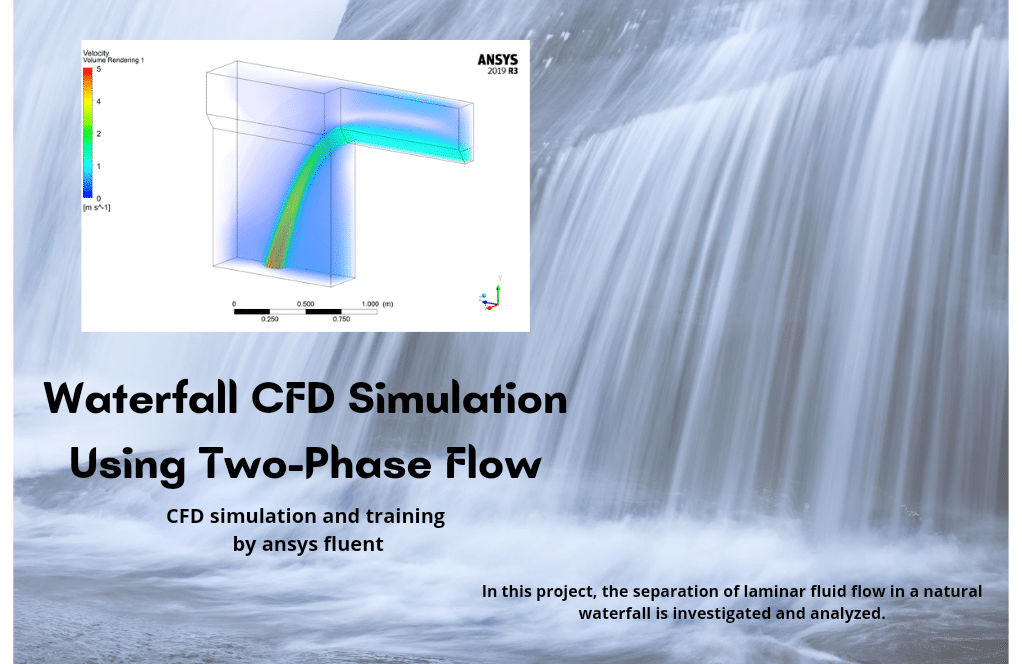
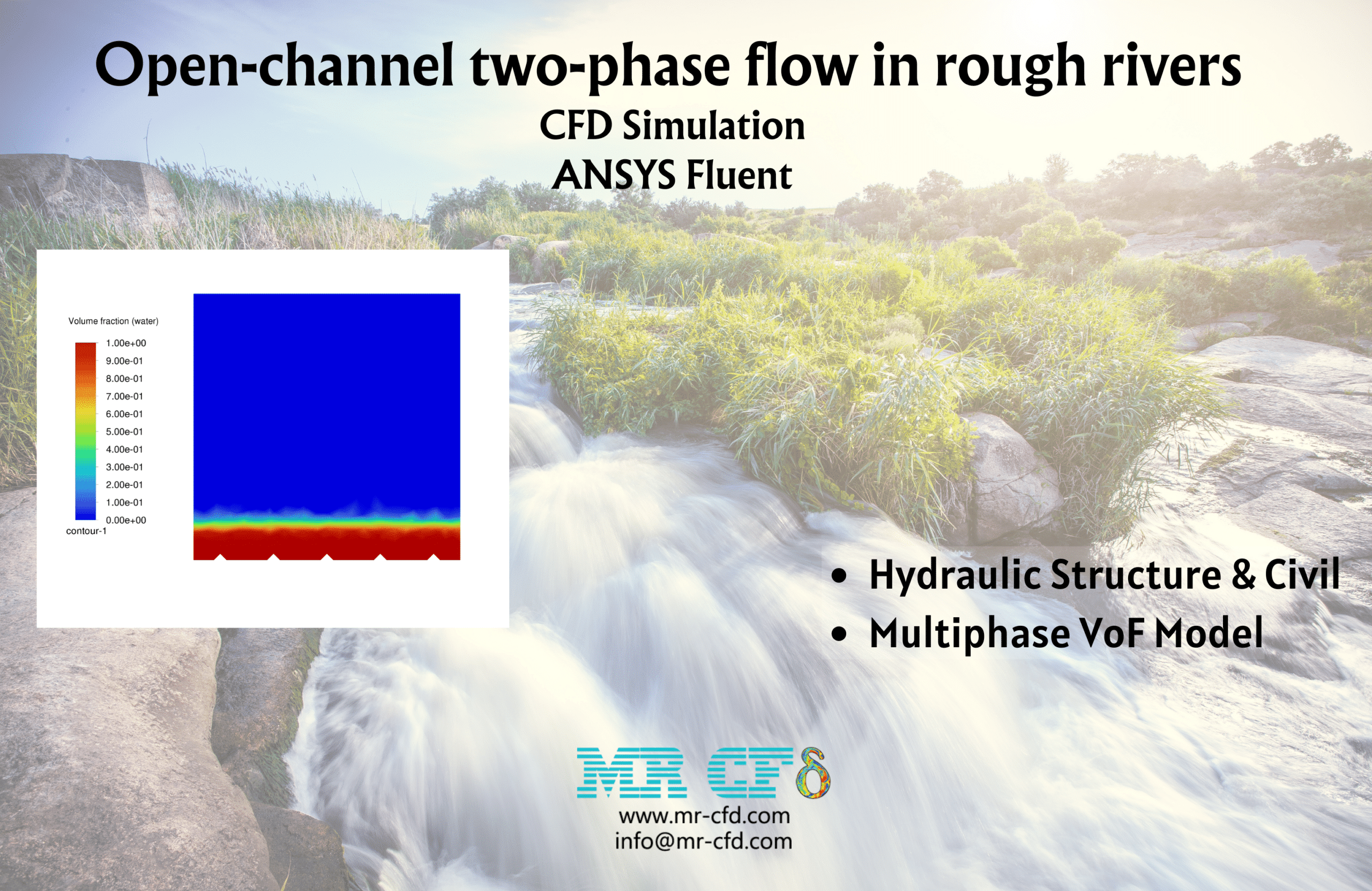


Dr. Xander Kuhn V –
The training for the Diaphragm Pump CFD Simulation was incredibly informative! I especially appreciated the focus on the dynamic mesh model and the practical UDF application.
MR CFD Support –
Thank you for your positive feedback! We’re glad you found the training informative and practical, and that you appreciated learning about dynamic meshing and User-Defined Functions (UDFs). We always strive to provide comprehensive training that enhances our customers’ skills in CFD simulation with ANSYS Fluent.
Prof. Heidi Haag –
The project on Diaphragm Pump CFD Simulation sounds fascinating, with the dynamic behaviors captured through simulation. Well done MR CFD Company!
MR CFD Support –
Thank you for your kind feedback! We’re thrilled to hear that you found our Diaphragm Pump CFD Simulation project insightful and engaging. It’s always our goal to offer comprehensive and practical learning experiences. Keep exploring our products, and don’t hesitate to reach out if you have any questions or need further assistance!
Anais Jacobson –
I must say, the Diaphragm Pump CFD Simulation training was incredibly detailed and comprehensive. The concept of modeling the reciprocating diaphragm and understanding fluid dynamics within the pump was fascinating and quite practical for real-world application. Thoroughly enjoyed the UDF programming for wall motion, and the dynamic meshing techniques were well-explained. Excited to leverage these skills in my work!
MR CFD Support –
Thank you for your positive feedback! We’re thrilled to hear that you found the Diaphragm Pump CFD Simulation training comprehensive and useful for understanding the intricacies of the pump’s operation. It’s great to know that the UDF programming and dynamic meshing techniques will be valuable in your work. If you have any further questions or need additional support, please don’t hesitate to reach out.
Dr. Nora Steuber Sr. –
My compliments to MR CFD for an excellent training package on Diaphragm Pump CFD Simulation. The approach used for modeling the reciprocating motion of the membrane was insightful, and I’m quite impressed with the clear way the Dynamic Mesh Model application was explained. Also, seeing the animation of the velocity and pressure contours really helped consolidate the understanding of the fluid’s behavior in the pump through the different phases of operation.
MR CFD Support –
Thank you for your kind words and the positive review! We’re thrilled to hear that our Diaphragm Pump CFD Simulation training has been helpful for you. It’s gratifying to know that the application of the Dynamic Mesh Model was clearly presented and that the animations provided you with a deeper understanding of the pump’s operation. We appreciate your feedback and look forward to assisting you in your future CFD learning endeavors!
Gabrielle DuBuque –
Is this project suitable for beginners who are just starting to learn about dynamic mesh and UDFs in ANSYS Fluent?
MR CFD Support –
Absolutely! This project offers a clear and practical example of using dynamic mesh and user-defined functions (UDFs) to simulate the complex movements within a diaphragm pump. It is a great way for beginners to see these advanced features in action and understand their application in real-world simulations.
Ivory O’Conner –
After reading about the Dynamic Mesh Model used, can you clarify how the UDF guides the deformation of the computational mesh over time?
MR CFD Support –
Certainly. A User-Defined Function (UDF) is prescribed to mathematically describe the movement of the diaphragm inside the pump. This function is then incorporated into the Dynamic Mesh Model, which is responsible for continuously updating the mesh in response to the wall’s wave-like motion. The motion defined by the UDF involves parameters such as displacement, velocity, and acceleration of the membrane, ensuring an accurate representation of its reciprocating movement is captured in the mesh deformation process.
Karine Rosenbaum –
Is it possible to observe the different stages of the pumping cycle through the output provided, like the suction and discharge phases?
MR CFD Support –
Yes, the simulation provides animated output that illustrates the pressure and velocity changes within the pump, hence you can observe the different stages of the pumping cycle including the suction when the membrane moves up and the discharge phases when it moves down.
Precious Nicolas –
I appreciate the detailed explanation provided in the diaphragm pump sim. Such a complex physics topic made clear through a simulation is really insightful. Well done!
MR CFD Support –
Thank you so much for your kind words! We’re delighted to hear that our Diaphragm Pump CFD simulation was insightful and helped clarify the complex physics involved. It’s always rewarding to know our efforts have positively impacted our users’ understanding. If you have any more questions or need further assistance, don’t hesitate to reach out!
Dr. Jorge Kohler –
I’m really impressed with the level of detail in the simulation of the Diaphragm Pump. How realistically does this CFD model replicate the performance of an actual diaphragm pump in operation?
MR CFD Support –
Thank you for your kind words. We have made considerable efforts to ensure that our CFD model closely replicates the actual performance of a diaphragm pump in operation. The model takes into account crucial factors like the reciprocal motion of the diaphragm, fluid dynamics, and the interaction between the liquid and the pump’s structure. While no simulation can capture every single detail, we believe that the results from our model offer a realistic and useful approximation of a real-life diaphragm pump’s performance.
Araceli Shields –
This training on diaphragm pump simulation sounds very informative. The detailed methodology and the practical application of a Dynamic Mesh Model help in understanding real-world pump mechanics.
MR CFD Support –
Thank you for your kind feedback! We’re delighted to hear that the course was informative and useful to your understanding of diaphragm pump simulations. If you have any further questions or require more in-depth training, feel free to reach out!
Dr. Cristian Johnson Sr. –
This CFD simulation for the Diaphragm Pump sounds incredible! The attention to detail in the modeling of the reciprocating membrane motion and the dynamic behavior of the fluid as a result is very impressive.
MR CFD Support –
Thank you for your positive feedback! We strive for accuracy and comprehensive analysis in our simulation projects. It’s great to hear that our dedication to depicting the complex motion of the diaphragm pump and its effects on fluid dynamics has made an impression. If you have any further questions or need assistance with similar simulations, don’t hesitate to reach out!
Ms. Gracie Ankunding –
What a great learning tool! I’m impressed with how the diaphragm pump CFD simulation could mimic the real motion and behavior of a pump membrane. The use of Dynamic Mesh Model along with a user-defined function for the wall’s wavy motion sounds fascinating. It’s clear that this project accommodates transient analysis effectively and makes the complex physics of pump operation so much more approachable. Seeing animation of the pressure and velocity contours add substantial educational value in visualizing fluid dynamics within a pump. Great job by the team to put together such a comprehensive simulation training module.
MR CFD Support –
We truly appreciate your kind words and are delighted to hear that our Diaphragm Pump CFD Simulation in ANSYS Fluent exceeded your expectations. We are glad that the training module’s dynamism and illustrative animations enhanced your understanding of the fluid dynamics within a pump system. Our dedicated team always strives to present intricate concepts in a digestible manner for our learners. Thank you for acknowledging our efforts; your positive feedback is highly motivating for us!
Bryana Hand IV –
I was impressed by the detailed simulation of the diaphragm pump’s reciprocating motion. It’s amazing how the fluid dynamics can be so accurately modelled. This ANSYS Fluent training materials really provide deep insights into the workings of the pump!
MR CFD Support –
Thank you for your kind words! We are thrilled to hear that our training material on Diaphragm Pump CFD Simulation using ANSYS Fluent was able to provide you with detailed and accurate insights into fluid dynamics and pump operation. Your satisfaction makes the effort we put into our learning products completely worthwhile!
Mayra Medhurst DDS –
The Diaphragm Pump CFD Simulation overview was concise and informative. The explanation about diaphragm pumps and the reciprocating motion simulation using UDF in ANSYS Fluent was particularly helpful in understanding how these pumps operate and how the simulation reflects real-life behavior. Well done on a robust simulation design and execution.
MR CFD Support –
We’re delighted to hear that you found the Diaphragm Pump CFD Simulation overview informative and that it helped enhance your understanding of the pump operations and simulation process. Thank you for your positive feedback, and should you have more inquiries or need further assistance in the future, feel free to reach out. Your success is our success!
Mr. Hardy Sipes –
I thoroughly enjoyed the comprehensive nature of this Diaphragm Pump CFD training. The blend of theory and practical applications, along with dynamic mesh methodology, really solidified my understanding of pump simulations in ANSYS Fluent.
MR CFD Support –
Thank you for your kind feedback! We’re delighted to hear that you found the training informative and practical. It’s great to know that the dynamic mesh methodology was beneficial to your understanding of pump simulations. We strive to provide comprehensive and realistic training experiences. If there’s anything else you’d like to learn or if you have further questions, please let us know!
Vilma Grady –
I’m truly impressed by the simulation capabilities demonstrated! The detailed movement of the diaphragm and its effects on fluid dynamics shown through animation is remarkable. It surely showcases the power of ANSYS Fluent in handling complex, dynamic simulations.
MR CFD Support –
Thank you so much for your kind words! We’re delighted to hear that you’re impressed with the diaphragm pump simulation and the capabilities of ANSYS Fluent. It’s great to know that the animation helped convey the dynamic nature of the pump. Your feedback is very much appreciated!
Prof. Prince Kshlerin –
This course seems really beneficial. Learning how to simulate the complex dynamics of a diaphragm pump is fantastic for my research. Great work!
MR CFD Support –
Thank you for your kind words! We are thrilled to hear that our Diaphragm Pump CFD Simulation course is contributing to your research. Your success is the best testament to the quality and applicability of our training materials. If you need further assistance or have additional inquiries in the future, feel free to reach out to us.
Jarred Anderson –
I was impressed with the dynamic modeling of the diaphragm pump movement! The UDF function’s competence in dictating the membrane’s motion truly showcases the versatility of ANSYS Fluent.
MR CFD Support –
Thank you for your kind words! We are delighted to know that the dynamic modeling capabilities and the use of UDFs in ANSYS Fluent have impressed you. Your feedback is greatly appreciated, and it motivates us to continue delivering high-quality learning materials.
Tatum McGlynn –
I’m genuinely impressed by the results provided by the Diaphragm Pump CFD Simulation. The dynamics captured through the ANSYS Fluent software, I believe, reflect a high level of precision. The use of the dynamic mesh to accommodate the membrane’s movements shows depth in understanding fluid-structure interactions at play in diaphragm pumps. Thank you for your detailed methodology; it’s quite educational.
MR CFD Support –
Thank you very much for your kind words! We’re delighted to hear that you’re impressed with the Diaphragm Pump CFD Simulation and the results. Our team works hard to ensure the accuracy and detail of our simulations, so your feedback is very much appreciated. We’re glad you found the methodology educational, as well. If you have further questions or need more information on our products, please feel free to reach out!
Miss Chelsie Deckow Jr. –
I absolutely loved the Diaphragm Pump CFD Simulation course! The use of a UDF to define the diaphragm’s reciprocating motion was insightful and the animations helped me understand the dynamic fluid behavior perfectly.
MR CFD Support –
We’re thrilled to hear that our Diaphragm Pump CFD Simulation course met your expectations and enhanced your knowledge! It’s great to know the animations and UDF method provided a clear insight into the fluid dynamics within the pump. Thank you for such a positive review and we look forward to providing you with more valuable learning experiences!
Prof. Norval Weissnat MD –
This product is incredibly extensive! The dynamics of the diaphragm pump were well-explained, and the simulation provided clear insights into the performance. Can ANSYS Fluent capture the fluid-structure interaction in cases like the deformation of the diaphragm, or is a different software required for that part of the simulation?
MR CFD Support –
Yes, ANSYS Fluent can simulate fluid-structure interaction (FSI) through its coupling with ANSYS structural tools, like Transient Structural, via System Coupling. The fluid dynamics and the structural deformation, as in the case of a diaphragm pump’s membrane, can be effectively captured, providing comprehensive insights into the behavior of the pump during operation.
Lura Corkery –
I found the project description of the Diaphragm Pump simulation so thorough and informative, showing a clear representation of dynamic behavior in mechanical pumps. The interplay of pressure, velocity, and membrane motion displays the complex nature of pump analysis using CFD very well.
MR CFD Support –
We appreciate your thoughtful comments regarding the Diaphragm Pump CFD Simulation project. It pleases us to hear that our detailed representation of dynamic elements within the simulation provided clear insight into the complexities of pump analysis. Thank you for taking the time to provide such positive feedback!
Verna Nicolas –
I was curious, when observing the complete CFD simulation, what specific part of the pump shows the most significant amount of deformation due to the membrane’s reciprocating motion? Could you clarify which area is most affected by this motion in terms of structural integrity?
MR CFD Support –
In the Diaphragm Pump simulation, the most significant deformation occurs in the mesh zone nearest to the reciprocating membrane. This is because the membrane’s movement directly affects the shape and volume of the chamber space, causing the surrounding mesh to deform to accommodate the motion. This dynamic interaction is central to the pump’s operation as it leads to suction and compression at the intake and outlet valves, respectively.
Dr. Lelah Zieme V –
Fabulous execution on the diaphragm pump simulation. The attention to realistic behavior within the CFD environment is commendable. Looking forward to utilizing these insights in our complex flow scenarios. Well done, MR CFD!
MR CFD Support –
Thank you so much for your kind words and for recognizing the hard work put into the Diaphragm Pump simulation. It’s fantastic to hear that the insights gained will be helpful in your flow scenarios. Your feedback is greatly appreciated!